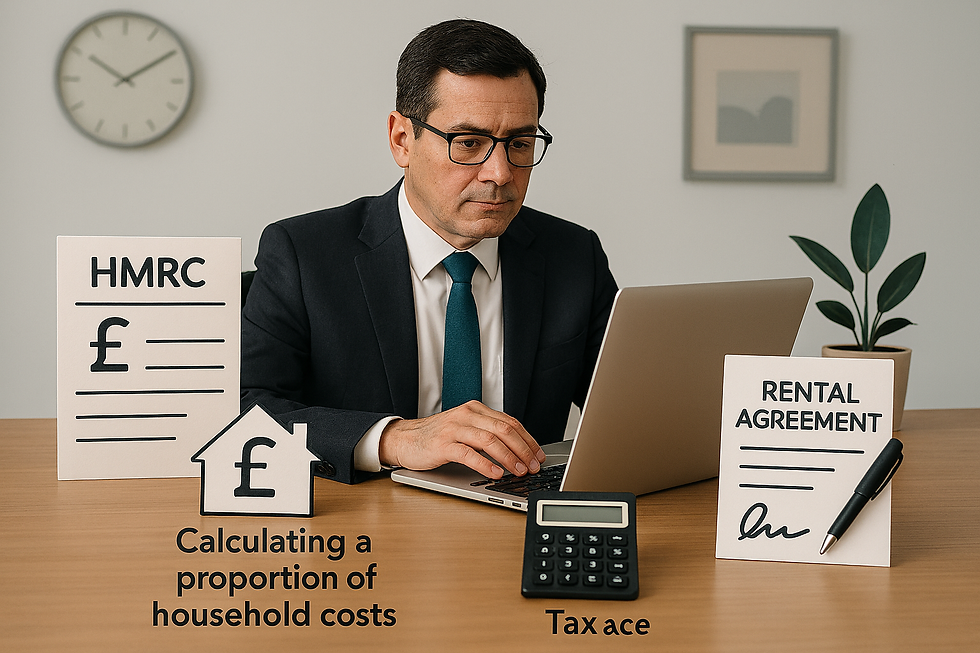Understanding UK Tax Codes: What They Mean and How They Affect Your Income
- nk2095
- Jun 30
- 3 min read
If you look at your payslip at the end of the month there will be a tax code. It is usually a combination of letters and numbers. Your tax code will effect how much income tax you pay on a monthly basis.
If your code is incorrect, it could end up in you over or underpaying tax throughout the tax year.

1. What Is a Tax Code?
A tax code is a series of numbers and letters used by HMRC to determine how much tax should be deducted from your income. The code reflects your tax-free personal allowance (the amount you can earn before paying tax) and any adjustments for allowances, benefits, or other income.
For example, in the 2025/26 tax year, most people have a Personal Allowance of £12,570, meaning you can earn up to this amount before being taxed.
2. Common UK Tax Codes and Their Meanings
Here are some of the most frequently used tax codes and what they mean:
a. Tax Code 1257L
Most common tax code: This code is standard for most taxpayers eligible for the full Personal Allowance.
Meaning: The numbers indicate a tax-free allowance of £12,570 (1257 x 10). The letter "L" means you’re entitled to the standard tax-free Personal Allowance.
Who it applies to: Employees with no additional allowances or taxable benefits.
b. Tax Code BR
Meaning: "BR" stands for "Basic Rate" tax.
Tax Rate: 20% of all earnings without a tax-free allowance.
Who it applies to: Often used for second jobs or pensions where all income is taxed at the basic rate. It assumes you’ve used your full Personal Allowance elsewhere.
c. Tax Code D0
Meaning: "D0" indicates that all income is taxed at the higher rate.
Tax Rate: 40% with no Personal Allowance.
Who it applies to: Used for additional income streams where the higher tax rate applies, such as high earnings from a second job.
d. Tax Code D1
Meaning: "D1" indicates that all income is taxed at the additional rate.
Tax Rate: 45% with no Personal Allowance.
Who it applies to: Typically for high earners in a second income stream exceeding £150,000.
e. Tax Code NT
Meaning: "NT" means "No Tax".
Who it applies to: Used in rare cases where no tax is payable, often due to certain reliefs or exemptions, such as foreign diplomats.
3. Emergency Tax Codes
If your tax situation is unclear (e.g., when starting a new job or if HMRC doesn’t have up-to-date information), you might receive an emergency tax code:
1257L W1/M1: Emergency code providing the standard Personal Allowance but calculated on a "Week 1" or "Month 1" basis.
0T W1/M1: No personal allowance is given, and tax is calculated only on a per-period basis (weekly or monthly).
Emergency codes are temporary and often lead to overpayment, so updating your employment details with HMRC is important to avoid errors.
4. Tax Code Letters and Their Meanings
The letters in your tax code indicate different circumstances that affect your tax status:
L: Standard tax-free Personal Allowance.
M: You receive a portion of your spouse’s or civil partner’s Personal Allowance (Marriage Allowance).
N: You’ve transferred some of your Personal Allowance to your spouse or civil partner.
T: Indicates that other calculations are needed, often due to complex tax situations.
K: Means you have a negative allowance due to untaxed income, tax owed from previous years, or certain benefits.
5. How to Check and Correct Your Tax Code
Your tax code appears on:
Your payslip
Your P45 (if you leave a job)
Your P60 (annual summary of your income and tax paid)
Steps to check your tax code:
Review your payslip or online personal tax account to verify your current tax code.
Check for changes: If you believe your code is wrong (e.g., you have started a new job, or your allowances have changed), contact HMRC directly.
The easiest way to change an incorrect tax code, is via your government gateway login.
6. Common Tax Code Mistakes
Common tax code issues can occur due to:
Changing jobs: Often triggers an emergency tax code.
Multiple income sources: You may be placed on the wrong code for secondary income.
Personal Allowance changes: Adjustments to the Personal Allowance can affect your code each tax year.
Unreported benefits: Benefits in kind, such as a company car, can affect your tax code.
Conclusion
Understanding your UK tax code is essential for managing your finances. Your tax code determines how much tax you pay, so knowing what each code means—and checking it periodically—can prevent overpayment and ensure you’re not underpaying. If your tax situation changes, updating HMRC promptly helps keep your tax deductions accurate and your take-home pay on track.
Speak to our team of tax accountants in London today to find out more.








Try the VAT calculator tool to quickly add or remove VAT and get accurate net or gross prices. Designed for simplicity, it helps you calculate the UK’s 20, 5, or 0 VAT rates in real time, saving you time on manual formulas and ensuring precise tax results for every transaction.